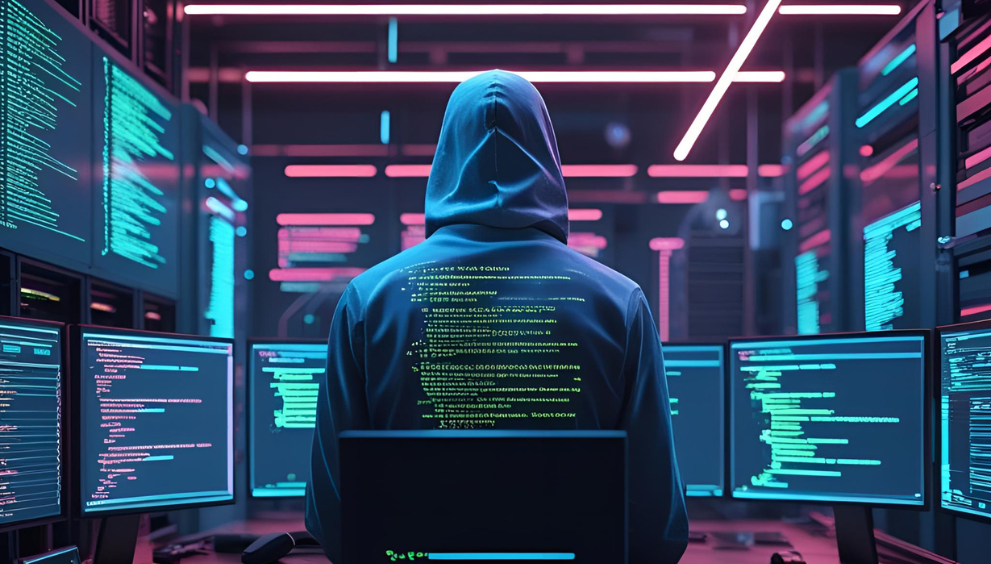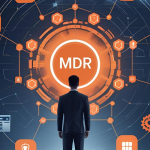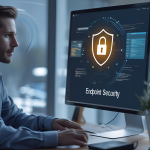Cyber threats are not just getting bigger; they’re getting smarter, sneakier, and far more unpredictable. As 2025 approaches, businesses in India and across the globe are seeing a sharp rise in complex cyberattacks. From AI-generated scams to threats against national infrastructure, cybersecurity is no longer a backend function. It’s now central to survival and growth.
In this blog, we’ll explore the top cyber security trends, highlight the new tactics used by attackers, and share expert cyber security predictions that Indian businesses must keep in mind to stay safe in 2025.
1. AI-Driven Threats and Defences
Artificial intelligence has completely changed the landscape of cyber security. It acts like a double-edged sword, a powerful tool for protection, but also a weapon for cybercriminals.
Rise of AI-Powered Cyberattacks
Attackers are now using AI to mimic human behaviour, automate phishing campaigns, and even build malware that changes form to avoid detection. Imagine getting an email that sounds exactly like your manager, or a voice call that sounds real but is entirely fake. These are no longer rare cases.
Deepfakes, automated social engineering, and AI-written code have made attacks faster and harder to trace. In fact, security experts warn that such attacks will become more common in sectors like banking, healthcare, and education.
AI-Enhanced Security Defences
Thankfully, AI is also being used to build smarter defences. With tools like Endpoint Detection and Response (EDR) and Security Orchestration, Automation, and Response (SOAR), organisations can now detect threats faster and act before damage spreads.
By learning what “normal” behaviour looks like inside a network, AI can quickly raise alarms when something strange happens, like someone accessing a server at midnight from an unknown location.
2. Zero Trust Architecture
As businesses move to hybrid work and cloud platforms, traditional security walls are no longer enough. Zero Trust has emerged as a key principle in cyber security technology, and 2025 will see its wider adoption.
Focus on Verification and Control
Zero Trust means “never trust, always verify.” Whether it’s a person, a device, or an application, everything must prove it belongs before being allowed access.
That’s where tools like multi-factor authentication (MFA), strict device policies, and least privilege access come in. These controls make sure only the right people get the right access, at the right time, from trusted devices.
3. Quantum Computing Threats
Quantum computing isn’t fully commercial yet, but the risks it brings are real, especially when it comes to breaking encryption.
Potential to Break Encryption
Today’s encryption systems, like RSA and ECC, rely on mathematical puzzles that take years for even supercomputers to solve. Quantum machines could solve them in hours.
This means hackers might store encrypted data now and wait for quantum tools to unlock it later, putting long-term privacy at risk.
Preparation for Quantum-Resistant Cryptography
To stay ahead, global bodies like NIST are already working on post-quantum cryptography standards. Businesses should begin assessing where encryption is used and look at transitioning to quantum-safe encryption methods before the change becomes urgent.
4. Advanced Ransomware and Extortion Tactics
Ransomware isn’t new, but in 2025, it’s evolving into something far more dangerous.
Increasing Sophistication
New ransomware attacks are using stealth delivery. Instead of crashing your system immediately, they sit quietly, observe your defences, and hit when least expected. Some attackers even personalise messages using stolen information to trick users into opening files or clicking links.
AI is also being used to improve how attackers pick targets, increasing their success rate.
Emergence of RaaS
Ransomware-as-a-Service (RaaS) has made it easier for non-technical criminals to launch attacks. They can rent tools, use readymade malware kits, and share profits with developers.
This trend is troubling because it opens the door to more attacks from people with very little knowledge or skill.
5. Intensified Focus on Cloud and IoT Security
With remote work, cloud tools, and smart devices becoming a part of everyday business, the attack surface has grown wider than ever.
Cloud Vulnerabilities
Many cloud attacks happen due to simple mistakes, misconfigured storage buckets, weak access controls, and insecure APIs.
Organisations must review their cloud settings regularly and implement proper identity access management systems to ensure only authorised users can access sensitive data.
IoT Security Risks
Smart cameras, printers, sensors, and home assistants, all these devices run on basic software, often without regular updates. Some still use default passwords. When connected to business networks, they become entry points for attackers.
The lack of visibility into these devices and the absence of centralised control create hidden risks.
6. Importance of Supply Chain Security
Many major cyberattacks in recent years didn’t come through the front door. They came through suppliers, partners, or third-party software providers.
Vulnerability through Third Parties
A single weak link in your supply chain can open your network to threats. This was seen in the SolarWinds breach, where a trusted software update was compromised.
To reduce risk, companies should demand better security from vendors, use tools like Software Bill of Materials (SBOMs), and regularly audit external access.
7. Heightened Regulatory Compliance and Privacy Focus
As attacks grow, governments are tightening rules. In India, the DPDPA (Digital Personal Data Protection Act) is a major step toward stronger privacy regulation.
Stricter Data Protection Laws
Apart from DPDPA, updates to GDPR in Europe and privacy laws in the US and Asia are also expected. These laws hold companies accountable for protecting user data and require fast breach reporting.
Compliance as a Priority
Security teams are now working hand in hand with legal and compliance teams. Tools that automate compliance checks, generate reports, and offer real-time dashboards are helping companies stay audit-ready without delays.
8. State-Sponsored Cyber Warfare
Geopolitical tensions are also playing out in cyberspace. In 2025, state-sponsored cyberattacks are expected to increase, especially against national infrastructure like energy grids, telecom, and transport.
Governments and large corporations will need to invest in cyber threat intelligence to track, understand, and prevent these well-planned and well-funded attacks.
9. Cybersecurity Mesh Architecture (CSMA)
As businesses grow across regions and devices, a centralised security system often falls short. That’s where Cybersecurity Mesh Architecture comes in.
CSMA allows companies to create multiple security layers across devices, applications, and users, all connected and working together as a flexible system.
In 2025, more Indian companies, especially in IT and finance, are expected to adopt this model for better visibility and response.
10. Emerging Technologies in Cybersecurity
Several tech trends are playing a positive role in protecting against future threats:
- Blockchain for data integrity.
- Behavioural analytics for insider threat detection.
- Quantum-safe encryption to prepare for tomorrow’s computing power.
- AI-powered automation for real-time threat response.
All these are shaping a smarter, more adaptive cybersecurity environment.
Stay Updated with Quick Heal
Staying ahead of threats means having the right tools and trusted partners. Quick Heal offers a range of solutions designed for modern threats, including:
- Endpoint Protection for real-time defence
- Data Loss Prevention (DLP) for safeguarding sensitive information.
- AntiVirus for Server to protect your backend systems.
- Total Security for all-around protection at the user level.
-
Multi-Device Security for businesses working across platforms.
-
Anti-Fraud solutions to stop phishing, scams, and payment fraud.
As cyber security threats become more advanced, Quick Heal continues to evolve its services to meet new challenges head-on.
Frequently Asked Questions
-
What is the scope of cybersecurity in 2025?
In 2025, cybersecurity will go beyond basic antivirus. It will include AI-driven detection, cloud protection, IoT management, and compliance support. Businesses of all sizes will need multi-layered defences to stay safe.
-
Why is zero trust architecture important in 2025?
Zero Trust removes the assumption that anything inside your network is safe. With remote work and cloud use growing, verifying every access request ensures better protection against insider threats and credential misuse.
-
How is AI impacting cybersecurity?
AI is helping in both attack and defence. While attackers use AI for phishing and malware, defenders use it for real-time detection, behavioural analysis, and automated response.
-
What is the role of cyber insurance in 2025?
Cyber insurance will continue to grow in importance. It provides a financial safety net after a breach, but insurers are also demanding proof of security controls, making companies improve their defence systems as a result.



